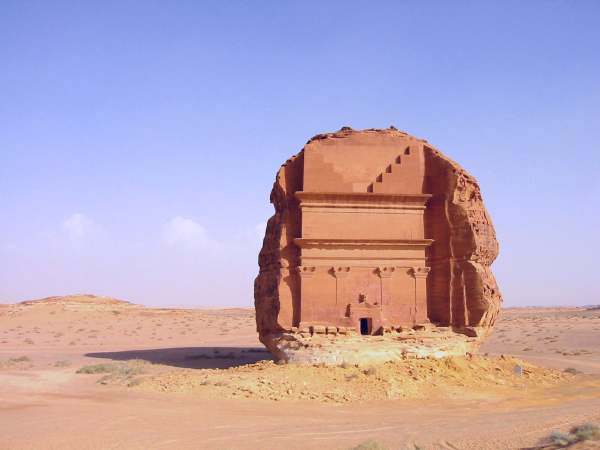



I love the story of this railway. In 1900 Sultan Abdul Hamid of Turkey, the last Caliph, worried about the rumblings of Arab discontent, initiated a plan to strengthen the Ottoman hold of the Arabia. With the declared aim of transporting pilgrims all the way from Damascus to the Holy Cities of Medina and Makkah, he started building a railway that was also supposed to provide means of moving Turkish troops easily into the heart of Arabia.
The Arab tribes did not like this idea. The railway was built under German supervision, so there were many Christian surveyors, engineers, foremen and labourers, and the Bedouins saw this as an infidel intrusion. More importantly, they made a living from annual raids on pilgrim caravans, and the railway would make these raids much less practicable. So, the railway building was under constant attack from the armed Bedouins.
As the first World War started, Turkey got on the opposite side of Britain and France, and when the Arab Revolt against the Turks broke, the British sent officers, such as T.E.Lawrence, to help the Arabs reclaim Arabia. One of the most effective ways of doing this was to blow up strategic points on the railway. The railway was not put out of action entirely, but enough to keep the maximum number of Turks relatively helpless and distracted. After the war it operated periodically, but the lack of repair and the damage from storms made it less and less attractive until it finally lost competition to road and air travel. This is all the is left of it.



As I mentioned earlier, Medain Saleh is the Nabataean sister city of Petra. It is located 800km North of Jeddah. The remains of Medain Saleh stand alone in an undulating sea of sand, with islands of weathered sandstone rocks, eroded and rippled into fantastic sculptural shapes. It is in some of these that the Nabataeans carved their monumental tombs. This was probably in the first century BC.



The legend has it, sanctified in the Koran, that Saleh was a pre-Islamic prophet. Medain Saleh means the "City of Saleh". The people in Medain Saleh refused to believe in God. The prophet Saleh tried to convince them otherwise, and even asked what they needed in order to believe. They replied that wanted a miracle. So in those hard times, he brought in a giant white camel, and if the people allowed the camel undisturbed access to their well every second day, the camel would give them enough milk forever. Not wanting to believe, some of the inhabitants killed the camel, with th result that they were destroyed by a bolt from heaven in retribution.



The inverted five-step pyramid design is a distinctive feature of the Nabataean tomb architecture. Nabataeans were traders between Jerusalem and the south side of the Arabic peninsula, and also other parts of the Ancient World, and their architecture shows influences of many of these cultures: North Africa, Persia, and even Romans. There are capitals and pediments in the style of Greece and Rome, there are solar discs, snakes, griffins, masks, and eagles. The rosette to represent a decorated dish used to pour some kind of liquid over the sacrificial body in religious occasions.

The first tomb is Qasr Al Farid, a single tomb carved from an isolated rock, left unfinished.


This chamber is the Diwan, thought to have been used for sacred banquets; it is pleasantly cool, facing north so that the sun never shines on it, with a continuous breeze.




The decorative eagles above the entrances to the tombs were considered idolatry, and as such nearly all of them have had their heads defaced by pious Islamic reformers. On the second photo, an inside view of the narrow gorge leading to the sacred space in the enclosure where we stand.


More photographs of my favourite part of the landscape: the Mammoth rock, and the surrounding landscape.


We drove around here for a while, on and off road. I enjoyed the desert drives. On the road, we meet very few cars. In several of them we saw children driving. A boy of 11 years of age would be driving, and his mother would be sitting in the passenger seat. Because women can't drive.



On the mountain-pass from Medina to Yambu, where we almost lost our brakes. Down from an altitude of 2000m to 900m in about seven minutes.

The old part of Yambu:


The present inhabitants of the house where Lawrence of Arabia once lived.

We had a sandstorm. It scraped of most of the painting on the bumpers on the car.

It even rained. The rain was great. I am used to crave sunshine, what with living in Norway and in England for too long. But here, I began to understand why Saudi people would get excited and say "It was such a beautiful day, it rained and rained heavily for hours; the water stood on the pavement; it was even foggy." OK, this was a short rainy spell, but it felt good anyway.






|
page 11 of 12
Silvija Seres, 25 April 2002